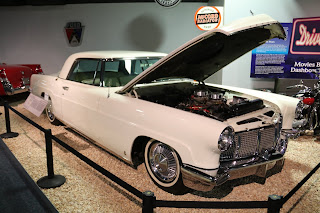Bill Harrah, the founder of Harrah’s Hotels and Casinos, was
an avid car collector and had an extensive collection. The following is a quote from Wikipedia:
“Harrah had an extensive
collection of cars. Many of his cars enjoyed 'best' or 'one-of-a kind' status.
After his death Holiday Inn acquired Harrah's of which the car collection was part of. The bulk of
the collection were sold at several auctions between 1984-1986 for more than
$100 million. An outcry by the people of Reno and Sparks led to Holiday Inn
donating 175 vehicles to establish the National Automobile Museum in Reno, Nevada, a collection also referred to as The
Harrah Collection. Some cars were also donated to form the Imperial Palace Auto Collection in Las
Vegas.”
We visited the National
Automobile Museum yesterday and were impressed. The museum is considered one of
the top five automobile museums in the US and has automobiles dating back to
1892. One thing that struck us was the profusion of early automobile startups.
There were many cars on display that we had never heard of because they either met
an early demise or were absorbed by another brand. It seems some things never
change and anytime a new technology emerges many hopeful entrepreneurs want to get
in on the action.
Another bit of trivia we
learned was that early automobiles produced in the US had their steering wheels
located on the curbside of the vehicle. This was a carryover from the horse and
buggy days when the driver preferred to sit on the curbside to judge his distance
for the road edge. When Henry Ford started producing the Model-T he relocated the steering
wheel to the roadside so the driver could judge his distance from oncoming
vehicles and allow passengers to safely exit the vehicles on the curb. Eventually other US manufactures followed his lead. In the following three photos notice the location of the steering wheel.
1910 Oldsmobile
1913 Pierce-Arrow
1913 Cadillac
The next photo is an early Ford Model-T. Notice the steering wheel location. Henry Ford did not invent mass-production manufacturing techniques but with the development of the Model-T in 1908 he produced a reliable, inexpensive automobile that truly mobilized America. From 1908 to 1927, more than 15,000,000 Model-T Fords were built and sold worldwide. Notice the Ford in the photo below is red. For the first few years the Model-T was available in many colors.
1909 Ford Model-T
My Dad owned a 1923 Ford Model-T that he purchased for $100 in 1955. The reason for purchase was because the county we lived in was celebrating their centennial anniversary and everyone was required to dress and live in the past on the weekends. The family rode around in that old Ford for weeks. Dad kept that Model-T for many years and refused many offers to purchase it. Finally in 1974 he traded it even for a brand new 1974 Chevrolet to the gentleman who owned the dealership.
My Dad and his old Model-T in 1955
In the museum many of the cars were displayed in a period setting including a few streets. One street was for the 1930's and included a Palace Theater with "Gone With The Wind" on the marque.
1930's street setting
Pam's favorite vehicle was a shinny 1936 Mercedes-Benz.
1936 Mercedes-Benz
We were not aware that in 1917 Chevrolet made an early attempt to produce a V8 with overhead valves. The engine size was 286 cubic inches and only produced 36 HP. The company abandoned the project in 1919 and concentrated on 4 and 6 cylinder engines until 1955 when they reintroduced the V8 with overhead valves. As Paul Harvey wound say, "the rest is history" and that design became the foundation for all modern gasoline internal combustion engines.
1917 Chevrolet with overhead valve V8 engine
Close up of the engine
The rich were attracted to large powerful automobiles and the manufactures were constantly introducing new models to meet their wishes. Here is a 1927 Lincoln with a 357 cubic inch V8 that produces 90 HP.
One of a kind 1927 Lincoln
The engine and transmission in the 1927 Lincoln
Here is another example of a powerful vehicle produced for the wealthy. This one is a 1948 Lincoln Continental with a 125 HP V-12 engine with only 292 cubic inches. Seems engine design was improving but they were still a long way from one horsepower per cubic inch.
1948 Lincoln Continental
V-12 engine in the 1948 Lincoln
Speaking of one horsepower per cubic inch, some of you may remember this early muscle car, I certainly do. It had a 425 cubic inch Hemi that produced 425 HP. These early muscle cars were death traps because they had tremendous power but poor handling and safety.
1966 Plymouth with 425 Hemi
Under the hood of the 66 Plymouth
While we are on the subject of powerful vehicles here are two that Bill Harrah had custom built for his personnel use. First is a 1956 Lincoln Mark II that he purchased new in 1956 and then later installed a 1958 Chrysler Hemi that produced 400 HP.
1956 Lincoln Mark II with 1958 Hemi engine
Bill liked to drive from Reno to Lake Tahoe in the winter and had a 1977 Jeep Wagoneer modified in his restoration shop to include a 12 cylinder, dual overhead cam Ferrari engine that produced 365 HP. He named the car Jerrari due to its hybrid nature. Notice the two radiators and not in view is a helicopter engine oil cooler. The headlamps are equipped with wipers and washers to remove snow and ice and located under the bumper are ice alerts. In fare weather this vehicle's top speed was 140 MPH.
1977 Jerrari
Under the hood
Gotta go now. Time to break camp and head for Yosemite.


















No comments:
Post a Comment